Nugget the cow: Seaweed-munching bovine chews on solution to methane problem
With a nose painted dark walnut, Nugget's body is the color of a lightly toasted marshmallow. Her hair is soft when brushed one way, coarse when brushed the other. Weighing a queen-size 1,200 pounds, she likes to retreat to the back of the barn after her afternoon feeding frenzy concludes.
It's clear she has a preference for solitude. Along with the waft of manure comes a sense of independence.
Nugget has a few piercings on her creamy oval ears, one being a bright yellow tag displaying her name and identification number: Bovine 145 at the University of New Hampshire's Organic Dairy Research Farm.
A second piercing is an electronic sensor that triggers a nearby machine to measure her burps. As an adult Jersey cow, Nugget's belching releases methane into the atmosphere, a potent greenhouse gas and the second most common behind carbon dioxide. But it's not necessarily the type of obnoxious, roaring discharge done by characters in cartoons.
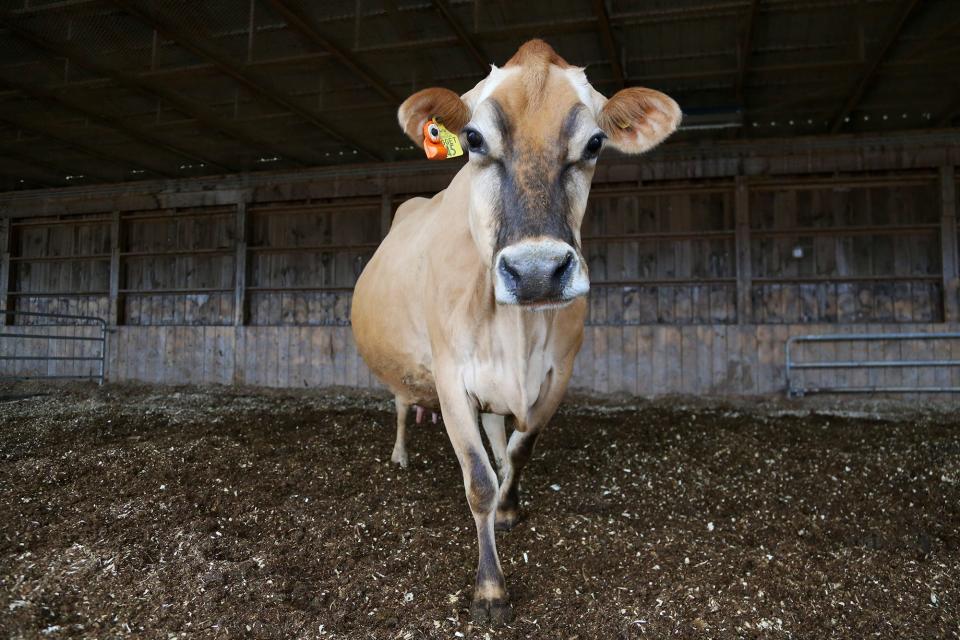
"It's quiet," Andre Brito, an associate professor of dairy cattle nutrition and management at UNH, said of the burps. "It's very difficult to actually hear."
As she saunters with attitude to her feeding stall, her enormous udder swinging between her legs, Nugget peers back, enveloping her dripping nose with her tongue in one swoop. No, she’s not a fossil fuel power plant or a gas-powered tractor trailer, but this blameless animal is, in fact, contributing to the climate crisis.
You’ve probably crossed paths with Nugget in the dairy aisle
Nugget is 8 years old, born in the summer of 2014. She’s spent her whole life at the UNH dairy farm, a flatland, agrarian setting on a backroad just 10 minutes from the state’s flagship university.
Her mother is named Aurelia and her father is the well-known Dutch Hollow Lexicon dairy bull, according to facility records. His semen doses have resulted in 4,567 daughters across 542 different herds, which means, sadly, Nugget is just a number to him.
She's a milk producer, not for meat consumption. Jersey cow milk is known for its richness, ideal for ice cream and yogurt because it contains higher butterfat than any other breed. If you've eaten anything from Stonyfield Farm, you might’ve consumed Nugget’s dairy in the form of vanilla fudge swirl frozen yogurt or a strawberry probiotic smoothie.
From Vermont: Two iconic organizations announce steps to address climate change
If her swollen udder didn’t give it away, Nugget is milking around 52 pounds daily right now, with a somatic cell count indicating a "very clean high-quality milk produced," said farm manager Ryan Courtright. He called her an “outstanding animal," her consistency of production excellent.
Producing milk for about 300 days per year, Nugget builds strong bones in humans with more calcium than other breeds and has an extremely high concentration of B2, or riboflavin, for body growth and turning carbs into fuel.
On the farm, where hay bales wrapped in white plastic are stacked next to a silo, Nugget’s colleagues go by names like Blueberry, Forsythia, Acorn, Maggie and Flannel. Nugget is a mother herself, and her two daughters are named Athena and Nougat.
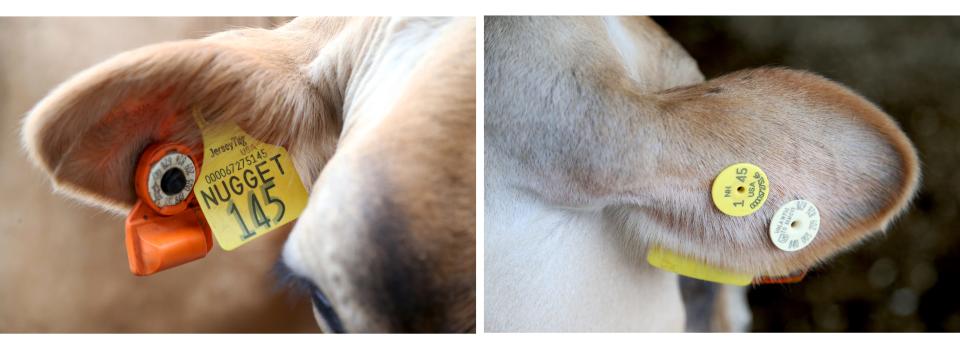
There’s more than 50 of them, and they’re all identified by yellow tags that farm staff use to track just about everything they do — like what they’re eating and when they’re lactating. There’s no privacy here, no secrets.
"This is a very friendly breed," said Brito, watching dozens of cows circumnavigate the fenced-in barn area. It’s cow pandemonium: mooing, defecating, urinating and chewing. Many stick their heads across the steel barriers looking to make acquaintance with visiting humans. Their craggy, blush pink and gray tongues search for something to slurp.
It's only ladies on the UNH farm — a lot of competitive estrogen energy in the air. When the males do visit, it's quick and solely for the purpose of impregnating; no love lost, no love found.
Cow burps give off methane: Here's what that means
Each year, Nugget and her numerous cow pals — roughly half a million of them in New England — generate about the same climate impact as nearly 240,000 gas-powered passenger vehicles driven for one year.
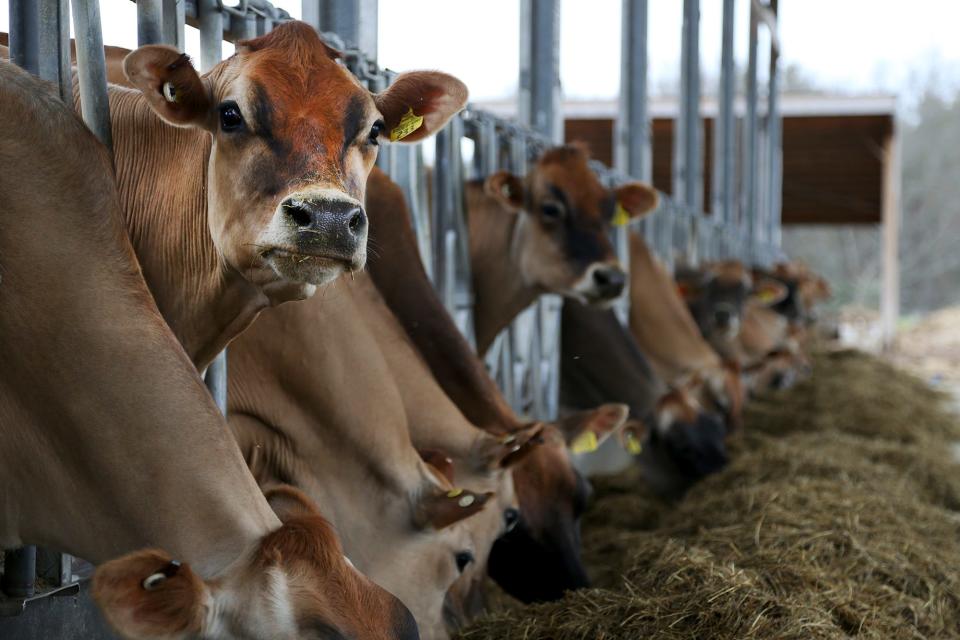
Methane is the same greenhouse gas the U.S. government may soon implement a fee on for all segments of the oil and gas industry, as part of a multi-billion dollar bill that would provide the most climate funding the country has ever seen.
We visited the farm during a USA TODAY Network reporting project called "Perilous Course," a collaborative examination of how people up and down the East Coast are grappling with the climate crisis. Journalists from more than 35 newsrooms from New Hampshire to Florida are speaking with regular people about real-life impacts, digging into the science and investigating government response, or lack of it.
What's in your natural gas, Vermont?: 'Digester' turns ice cream, beer and manure into fuel
Nugget's annual contribution to global warming is about 220 pounds of methane. It’s a significant carbon hoofprint when you look at the scale of the dairy and meat industries globally.
If you were face-to-face with Nugget right now, watching her savor hay and corn silage, chances are she’d be expelling gas without you even knowing.
A day’s feed for Nugget weighs as much as a middle school child, and that process is punctuated by burps. She’s a ruminant, as are all cows, reliant on the microbial fermentation process that takes place in their four-chamber stomachs during digestion.
After initial digestion, Nugget regurgitates her food, chews the cud further and then re-swallows it. It's a natural process that produces “enormous, even frightening" amounts of gas, as noted by one university’s research. It’s not Nugget’s fault; she was born this way.
Enter seaweed. Yes, the slimy ocean vegetable. The soaked, tentacled, hairy object children hurl at each other while swimming at the beach.
Seaweed can act as a natural Gas-X of sorts for cows. And here’s why our hero Nugget and her many, many friends are getting this attention. They’re test subjects to help scientists discover which types of seaweed could potentially make a dent in cow-induced climate change.
Cows are eating seaweed to reduce methane
Nugget’s farm is part of a handful of federally funded projects in New Hampshire, Vermont and Maine where researchers are exploring different seaweed species, particularly those local to the Northeast, and how they impact the amount of methane cows burp.
Most cows will never dip a hoof in the ocean, and dining on saltwater plants seems strange for that reason. But seaweed is loaded with vitamins and minerals, and started gaining more attention in recent years after lab tests and trials in Australia saw remarkable reductions in cows’ methane output.
Farmers have historically used kelp feed for cows because of its impact on body composition, pregnancy and reduction of milk somatic cell count, a lower count indicating good animal health.
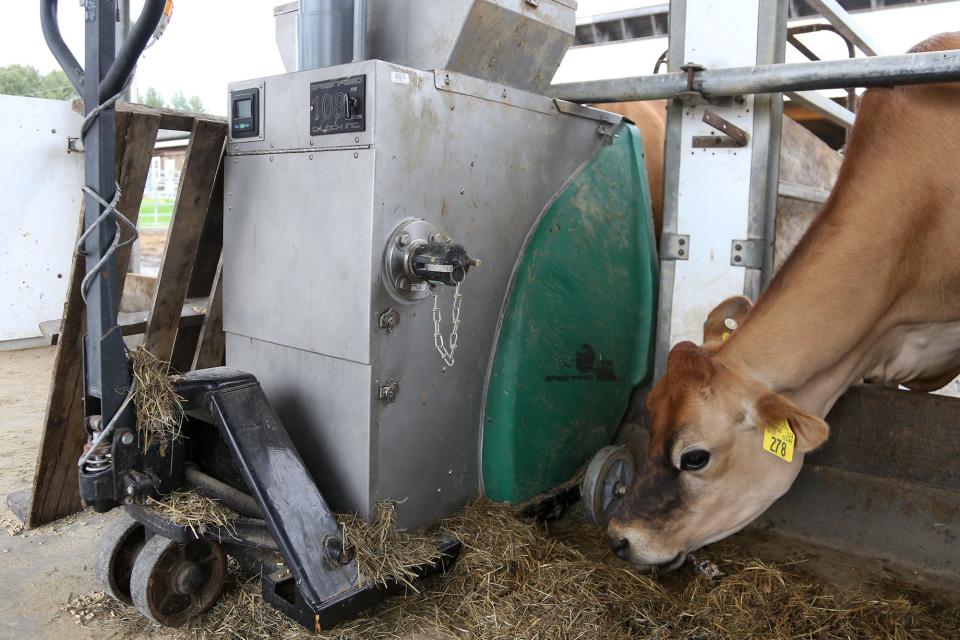
One of the tags on Nugget's ear triggers a GreenFeed system that she takes turns entering throughout the day. The $60,000 contraption releases pellets for Nugget to eat in timed increments, measuring her methane output while her head is inside a chamber. Numbers are then transmitted to a server for researchers to review, allowing them to see how different seaweeds, or other diet additives, are impacting the cows' methane levels.
"They're belching and breathing, and all of that methane gas is then captured and measured by sensors located inside of the equipment," said Brito.
In Rhode Island: Woman builds 'bull market' to save dairy steers from veal industry
Sabrina Greenwood, an associate professor in the University of Vermont's Department of Animal and Veterinary Sciences, said while seaweed might appear as a diet manipulation to some, reducing methane output is a "good thing" for cows like Nugget. Expelling gas is tiring, after all.
"Methane getting burped out is energy they are losing," she said. "This represents an energy loss for an animal."
If Nugget can produce less methane, she’ll likely have more energy to produce milk, enjoy life on the farm and invest in her hobbies — like eating.
How does seaweed reduce methane in cows?
A few miles up the coast from Nugget’s farm, a member of the red algae family of seaweed is growing in the Gulf of Maine. Fanning out like branches on a miniature tree, it’s lubricious and jelly-like under water. The species, Irish Moss, can turn from a garnet red and brown color to blonde when dried. It's brimming with nutrients, and typically harvested between April and September along the Maine coast.
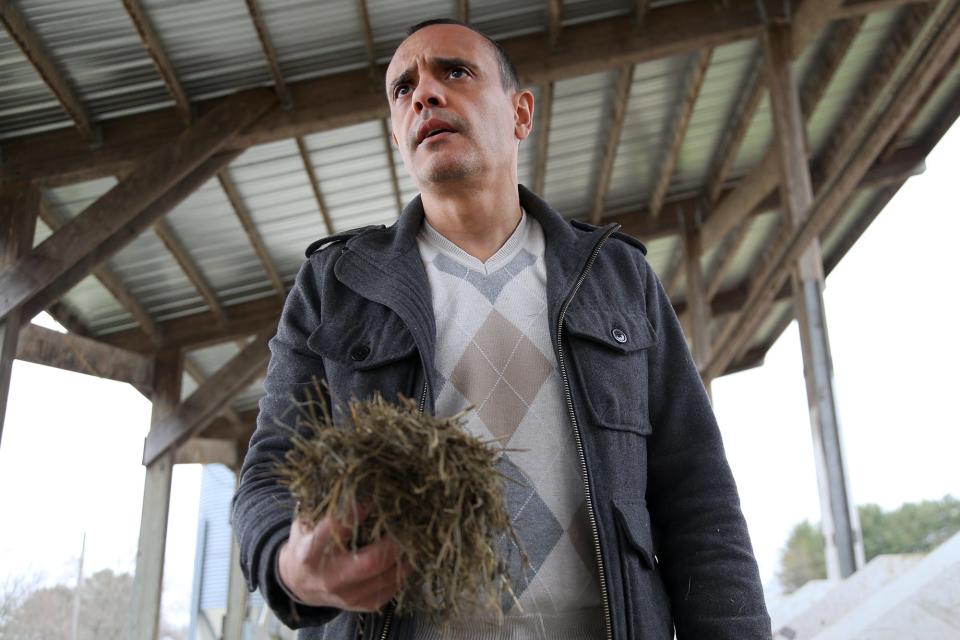
The Northeast research team is looking closely at which seaweed species are most optimal for methane reduction, cow and human health, and the environment.
A very important question is whether Nugget and her friends will eat it. They don’t have a natural palate for seafood.
"Like cafeteria-style, you're going to put different types of seaweed and mix them with hay and see what (the cows) like best," Brito said. "They're able to differentiate a very small difference in nutrient concentration. You need to mask by mixing."
Cows at the UNH dairy farm and Wolfe's Neck Center in Freeport, Maine, have been seaweed trial subjects. At Bigelow Laboratory for Ocean Sciences an hour away from Wolfe's Neck, a marine ecologist has been feeding seaweed to “fake cow stomachs” housed in glass bottles.
Making clean energy: Meet our energy future: Factory helps turns old batteries into new
It’s all focused on species like Irish Moss that are "native and can be produced sustainably at scale," said benthic marine ecologist Nichole Price. Without that, the greenhouse gas emissions produced by transporting seaweed cross-country via gas-powered trucks, for example, could ultimately offset any emission reduction seen in cows.
"The production itself of the algae also has to be environmentally sustainable," Price said. "From the point where an aquaculturist is deciding to grow seaweed and create a product, what are the environmental (impacts) and greenhouse gas emissions at every step of that process?"
Questions remain around seaweed for cows
The Gulf of Maine’s Irish Moss is presenting itself as a potential solution, though much research remains until Nugget et al claim it as a winning choice. Trials have shown up to a 20% reduction in methane emissions when adding Irish Moss to cow diets over a nine-week period, Brito said.
For Nugget, that would mean around 44 less pounds of methane per year. Talk about gas relief! For the close to half a million cattle like her in New England, that’s a total reduction of more than 19 million pounds per year.
"For what we can grow in the Northeast, maybe we'll only get a 30% reduction," Greenwood said, “but that multiplied by the number of animals, that's big."
Earlier this year: Organic dairy co-op offers membership to 80 Northeast farms to preserve milk market
Asked if it appeared the cows liked the Irish Moss, Brito said, "They ate it."
For Nugget and the herd, seaweed seems like it could be a successful bet. But there are still questions surrounding it, like the impact on milk, meat and human health, or how ocean ecosystems could handle large-scale seaweed cultivation.
Northeast researchers intend to address lingering questions and more about seaweed potential. In the meantime, it’s Nugget and her comrades who will be doing the ruminative work and supplying the real answers, burp by burp.
— This article is part of a USA TODAY Network reporting project called "Perilous Course," a collaborative examination of how people up and down the East Coast are grappling with the climate crisis. Journalists from more than 35 newsrooms from New Hampshire to Florida are speaking with regular people about real-life impacts, digging into the science and investigating government response, or lack of it.
This article originally appeared on USA TODAY NETWORK: How UNH researchers are using seaweed to reduce methane from cow burps

